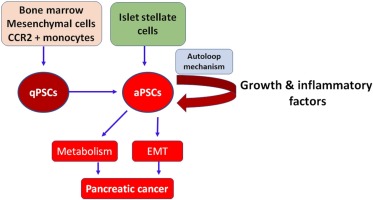当前位置:
X-MOL 学术
›
Cytokine Growth Factor Rev.
›
论文详情
Our official English website, www.x-mol.net, welcomes your feedback! (Note: you will need to create a separate account there.)
The dynamic interactions between the stroma, pancreatic stellate cells and pancreatic tumor development: Novel therapeutic targets.
Cytokine & Growth Factor Reviews ( IF 13.0 ) Pub Date : 2019-07-17 , DOI: 10.1016/j.cytogfr.2019.07.001 Batoul Farran 1 , Ganji Purnachandra Nagaraju 1
Cytokine & Growth Factor Reviews ( IF 13.0 ) Pub Date : 2019-07-17 , DOI: 10.1016/j.cytogfr.2019.07.001 Batoul Farran 1 , Ganji Purnachandra Nagaraju 1
Affiliation

|
The stroma is a main driver of metastasis and aggressiveness in pancreatic cancer (PC), one of the deadliest malignancies worldwide. Pancreatic stellate cells (PSCs) form approximately 50% of the pancreatic tumor stroma, causing desmoplasia, extracellular matrix (ECM) deposition, epithelial-to-mesenchymal transition (EMT) and metastatic spread. Furthermore, activated PSCs can remodel the pancreatic tumor microenvironment (TME) via dynamic and complex interactions and feedback loops with PC cells, thus facilitating tumor growth through various signalling and immune pathways. Hence, increased understanding of these cellular cross-talks and how they shape the TME in PC might guide the development of novel treatment approaches against this stubborn and deadly malignancy that has so far resisted therapeutic advances. In this review, we will explore the role of the stroma and PSCs in PC development, invasion and metastasis, examine their interaction with PC cells and discuss potential treatment approaches aimed at targeting PSCs in order to reprogram the pancreatic tumor environment.
中文翻译:

基质,胰腺星状细胞与胰腺肿瘤发展之间的动态相互作用:新型治疗靶点。
基质是胰腺癌(PC)转移和侵袭性的主要驱动力,胰腺癌是全球最致命的恶性肿瘤之一。胰腺星状细胞(PSC)约占胰腺肿瘤基质的50%,引起增生,细胞外基质(ECM)沉积,上皮-间质转化(EMT)和转移扩散。此外,活化的PSC可以通过动态和复杂的相互作用以及与PC细胞的反馈回路来重塑胰腺肿瘤微环境(TME),从而通过各种信号和免疫途径促进肿瘤的生长。因此,对这些细胞串扰的更多了解以及它们如何塑造PC中的TME可能会指导针对这种顽固而致命的恶性肿瘤的新型治疗方法的发展,而这种恶性和致命性恶性肿瘤迄今仍无法治疗。在这篇评论中,
更新日期:2019-11-18
中文翻译:

基质,胰腺星状细胞与胰腺肿瘤发展之间的动态相互作用:新型治疗靶点。
基质是胰腺癌(PC)转移和侵袭性的主要驱动力,胰腺癌是全球最致命的恶性肿瘤之一。胰腺星状细胞(PSC)约占胰腺肿瘤基质的50%,引起增生,细胞外基质(ECM)沉积,上皮-间质转化(EMT)和转移扩散。此外,活化的PSC可以通过动态和复杂的相互作用以及与PC细胞的反馈回路来重塑胰腺肿瘤微环境(TME),从而通过各种信号和免疫途径促进肿瘤的生长。因此,对这些细胞串扰的更多了解以及它们如何塑造PC中的TME可能会指导针对这种顽固而致命的恶性肿瘤的新型治疗方法的发展,而这种恶性和致命性恶性肿瘤迄今仍无法治疗。在这篇评论中,



























 京公网安备 11010802027423号
京公网安备 11010802027423号